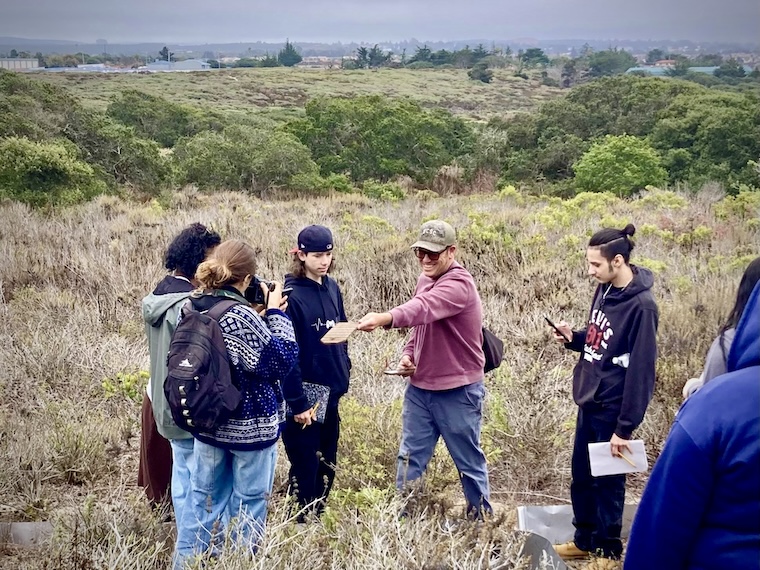Campus News
Fort Ord reserve inspires youth to consider careers in natural science, conservation
As the only full-time staff member at UC Santa Cruz’s Fort Ord Natural Reserve, Director Joe Miller doesn’t need to create more work for himself. And yet, he’s managed to do just that by successfully partnering with a nearby charter high school that brings students onto the 610-acre property to teach them about local natural history and introduce them to career pathways in natural science and conservation.

As the only full-time staff member at UC Santa Cruz’s Fort Ord Natural Reserve, Director Joe Miller doesn’t need to create more work for himself. And yet, he’s managed to do just that by successfully partnering with a nearby charter high school that brings students onto the 610-acre property to teach them about local natural history and introduce them to career pathways in natural science and conservation.
In the fall of 2022, Miller collaborated with leaders at Learning for Life Charter School, also in the central-coast town of Marina, to create a program that brings its students to the reserve for a series of four visits each semester. The program provides the youth with an uncommon experiential learning opportunity and introduces them to undergraduates from UC Santa Cruz and CSU Monterey Bay who come to the reserve to volunteer or conduct research.
The program has so far met its goal of keeping students at the independent-study charter school—the majority of them defined as “high risk” by the state due to their foster or homeless status—interested and enrolled in their science class. Miller intends to continue the program this coming fall.
“At a basic level, we all benefit from space and time in nature. I like to remind folks that they belong where they are when visiting the reserve, to let themselves sink in a little and reflect,” Miller said. “Providing this space for these young people is an important public service.”
Miller leads the visits and is often accompanied by the university students, who relate their college experience and answer questions from the group. The first visit is a general tour of the reserve, where students learn about different habitat types, soil, and climate that has shaped the unique maritime chaparral there. Subsequent visits narrow focus on topics such as herpetology, mammalogy, and field data-collection methods.
On every visit, students learn nature journaling techniques and have time to quietly consider their observations for the day. The final visit to the reserve involves a plant survey that acts as an introduction to quantitative field methods, and basic indices are introduced. Students then return to their school and tie everything together with their instructors, referencing their field journals from the semester to create a final project.
“With additional funding for university student staff, we would love to expand on the concept for other local schools,” Miller said.
The high school program is just one of many at the reserve, which hosts students from UC Santa Cruz, CSU Monterey Bay, San Jose State University and others—representing about 20 different college courses—to conduct field research and learn about ecology and conservation. The reserve consists of maritime chaparral habitat that is home to many rare and endemic species, as well as grasslands, coastal scrub, and oak woodland habitat.
Formerly the Fort Ord U.S. Army Base, the site was chosen as a UC natural reserve due to the unique vegetation and sensitive and listed plant and animal species that occur throughout the reserve—including the federally endangered sand gilia, state-endangered seaside bird’s beak, and the federally threatened Monterey spineflower.
Today, the reserve supports long-term climate change research and transformative field experiences designed to inspire a new generation of natural scientists, from K-12 to college students. It is part of the UC Santa Cruz Natural Reserves system, which also includes Año Nuevo, Younger Lagoon, and Landels-Hill Big Creek. The system is overseen by UC Santa Cruz Natural Reserves Director Gage Dayton with the support of his team.
Miller is supported by the efforts of dozens of interns and volunteers each year, and donations to Fort Ord Natural Reserve allow him to hire seasonal and special-projects staff on a short-term basis. These opportunities provide valuable experience and income to students, recent graduates, and other members of the research community.
About 70 percent of Learning for Life’s students are there because they haven’t connected well with traditional school settings, whether that’s due to expulsion, teen pregnancy, or other personal challenges, according to Barbara Lawrence-Emanuel, the charter school’s associate director.
But, she adds, her students are trying. And after a day of being out at the reserve among university students and working scientists like Miller, they start to realize that they, too, can pursue a career in research or conservation. They’ve held native wildlife like a California pocket mouse or kingsnake in their hands, and they’ve been introduced to field data-collection methods by doing plant surveys—kneeling in the sand, with the coastal breeze in their face.
“Their families do not have the downtime to take them to places like this easily. Or their lives are not constructed in such a way that that’s happening for them,” Lawrence-Emanuel said. “It is a deeply enriching experience for them. And being in nature, of course, is always phenomenal.”